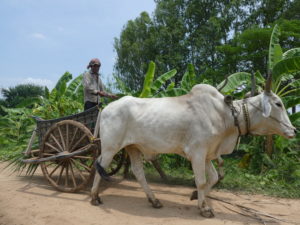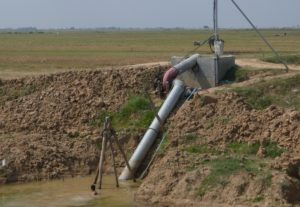In Cambodia, few people talk of the Mekong “delta” that is rather associated to Vietnam. This happens even though the delta hydrographically “begins” by Phnom Penh where the river first branches out and the Bassac River flows roughly parallel to the Mekong mainstream for about 70 km before both rivers cross the border and continue their journey towards the sea.
In this context, the research focused on (1) collective instances of natural resource management and (2) a specific type of infrastructure called “preks” – sedimentation canals excavated during the colonial area for the purpose of intensifying agriculture, and used for multiple purposes since then. Research was conducted in two Cambodian provinces, Takeo and Kandal, and involved the development of a serious (role playing) game.

In Takeo province, the research focused on analyzing rice-based agricultural systems and irrigation management modalities and the role that Water User Groups (locally called Farmer Water User Community -FWUC) can have in ensuring sustainable irrigation. Unsurprisingly, and as observed in many countries, the research highlighted the lack of willingness of the Cambodian irrigation administration to truly devolve decision making responsibilities to irrigators and the priority it gave towards building new infrastructures and conducting large-scale rehabilitation rather than supporting routine maintenance. This has several reasons and notably (1) the visibility that new water control infrastructures provide to a government that seeks electoral support from its rural base, (2) the fact that infrastructure construction is a modern re-enactment of the grandeur of Angkor and (3) the opportunities it provides for personal enrichment. The research also highlighted that irrigation management in the Takeo floodplains was the result of an “institutional bricolage” and that farmers-cum-entrepreneurs owning diesel pumps played a key role in shaping access to resources (canal infrastructures and water) and deriving significant surplus from it including through land purchase (Phoeurk and Venot, 2019; Venot et al., 2019). This happens in a context whereby the low profitability of paddy directly exported to Vietnam and still unreliable access to water has pushed a significant number of small-scale farmers into debt and migration (Fétiveau, 2019).
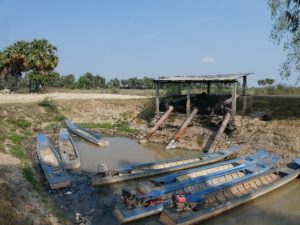
In Kandal province, the research focused on collective fishery management and the rehabilitation of irrigation and drainage earthen channels, dating back to the colonial period, and locally called “preks”.
In Kandal, fishermen groups (locally called Fishery Communities) were established in the mid-2010s after private fishing concessions were cancelled following an electoral promise “to redistribute fish to the Cambodian people”. Members of the group can fish for self-consumption and the group is responsible for preserving the (fishery) resources – notably making sure there is no illegal fishing activity in the area it is meant to oversee. In Kandal, the fishery administration has granted some fishery communities a special right to engage in commercial activities, so as to catch fish before it goes to Vietnam. In some cases, fishery communities have devised innovative ways to deal with uncertainty in hydrological regimes and related fish catch and distribute risks and benefits in an equitable way among their members. In other cases, middlemen who provide the initial capital to build the collective fishing systems reap the most benefits (as holder of concession rights did 10 years ago) (Venot and Phoeurk, 2019). In all instances, fishery communities face difficulties to control widespread small-scale and commercial illegal fishing activities. They are also under pressure from the fishery, police and administrative authorities, which divert up to half the fishing revenues. The research also shows that the dismantlement of the private fishing concessions led to (mostly non official) large scale land use change. The natural vegetation was cleared and replaced by maize and rice plots. This, together with changes in the flood regime of the Mekong, leads to a significant decrease in the size and productivity of floodplain fishing grounds. Households from the Cham (Muslim) minority who often live on boat and move across the floodplain, “following the fish”, are the most affected by these trends as they are progressively ‘pushed’ to less productive areas.
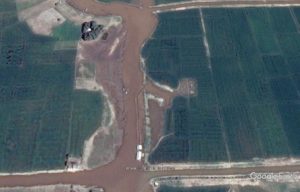
Participatory research and serious game
Finally, in Kandal province, hundreds of earthen channels excavated in the late-19th century and diverting water perpendicularly from the main river streams towards low lying floodplains (locally called Boeung), can be found. These channels are locally called “preks” and have been used for multiple purposes over the last 150 years: sedimentation, navigation, fishing ground, irrigation or flood management canals, etc.
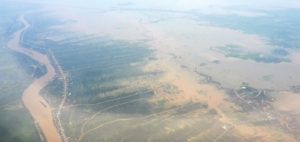
The research first focused on better understanding the hydrological functioning of these systems (Pratx, 2017) and local perceptions of risks and uncertainties (Vauthier, 2019) in the context of on-going rehabilitation projects. This served as a basis for developing a serious role playing game to discuss modalities of infrastructure development and related trade-offs. Participatory working sessions were organized with farmers in two specific communities as well as with local elected officials, representative of line ministries at provincial levels, researcher and staff from development agencies. The participatory workshops stressed the in-depth knowledge that local inhabitants have of the multiple and complex socio-environmental dynamics in the prek area. They also highlighted that current rehabilitation projects remain focused on the construction of grey infrastructures for water control and agricultural intensification and the need to better recognize the multiple uses and services provided by the floodplain (Venot, 2018; Venot, 2019). Results from these research activities have informed past and current prek rehabilitation projects, contributing to the adoption of a more just and integrative approach recognizing social and environmental diversity.

